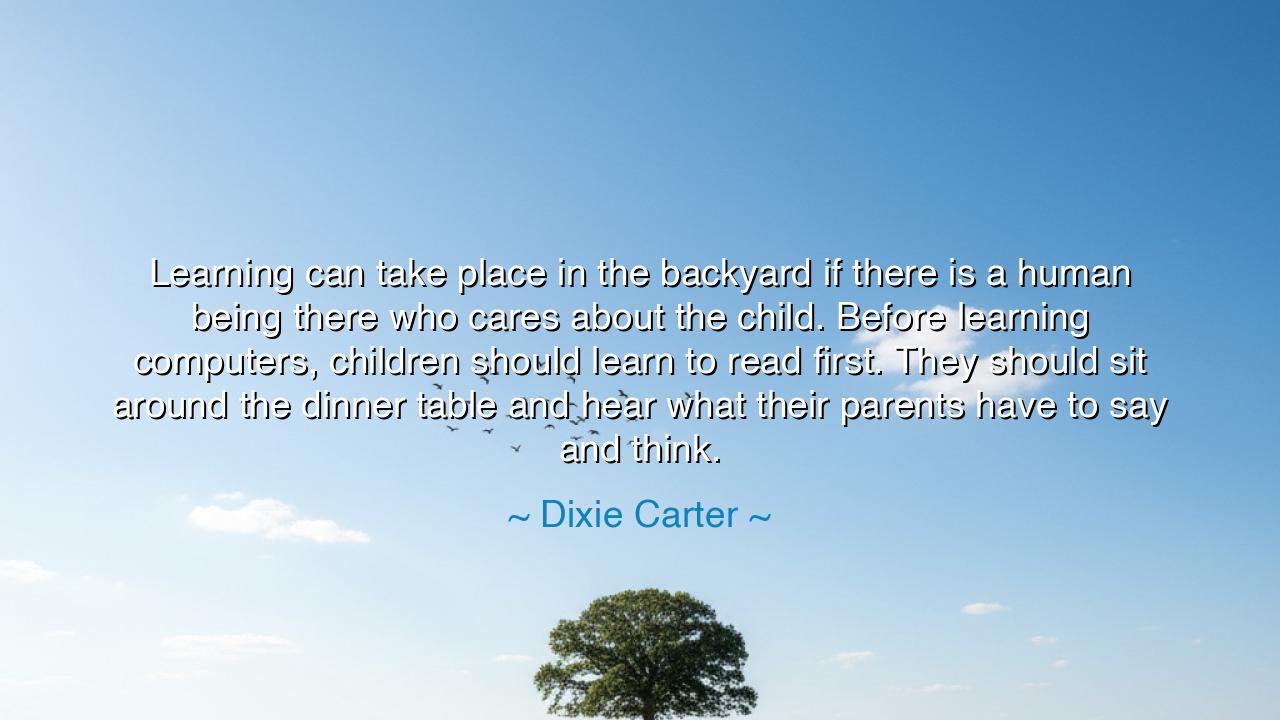
Learning can take place in the backyard if there is a human being
Learning can take place in the backyard if there is a human being there who cares about the child. Before learning computers, children should learn to read first. They should sit around the dinner table and hear what their parents have to say and think.






"Learning can take place in the backyard if there is a human being there who cares about the child. Before learning computers, children should learn to read first. They should sit around the dinner table and hear what their parents have to say and think." – Dixie Carter
In the quiet, sacred spaces of life, learning is not always found within the walls of a formal institution, nor in the sterile hum of a machine. Dixie Carter speaks to a profound truth about education: learning takes root where the human heart is present. She reminds us that education is not solely about what a child can learn from a book or a computer, but what they absorb from the world around them—from the voice of a parent, the warmth of a home, and the exchange of thoughts and ideas around the dinner table. The backyard, symbolizing the simple and humble environments of life, becomes a place of learning when it is infused with the care, wisdom, and presence of those who guide the next generation.
In ancient cultures, education was not confined to the classroom or the written word alone. The great philosophers of Greece, such as Socrates and Plato, believed that learning was a dialogue, a conversation that took place between individuals, a sharing of ideas, thoughts, and reflections. Socrates famously taught through questions, encouraging his disciples to engage with the world around them through critical thinking. The Socratic method, based on dialogue, illustrates that learning is most powerful when it is shared, when it moves beyond the individual and becomes part of a communal process of discovery. Similarly, Carter’s message echoes this age-old wisdom: the most essential lessons are learned not in isolation but in the connection between human beings—particularly between parents and children.
The simple act of sitting around the dinner table is, in its essence, a ritual of shared learning. It is a time when ideas flow freely, when children can hear the thoughts of their parents and others, and begin to understand the world in all its complexity. In this space, children are not just fed nourishment for the body, but also for the mind. Just as the ancient Greeks gathered in the Agora to exchange ideas and to shape the fabric of their society, so too do families gather at the table to shape the minds of the next generation. The dinner table is not merely a place for food, but a place for conversation, for the exchange of values, beliefs, and stories that create the foundation for learning.
Consider the story of Benjamin Franklin, who, in the early years of his life, learned much of what would shape him into one of the greatest minds of his time, not from formal schooling, but from the conversations around his family’s table. Franklin’s father, who had little formal education, would engage him in long discussions about books, ideas, and life itself. These conversations, often simple but rich in wisdom, were the true foundation of Franklin’s vast intellect. This story is a testament to the power of human connection as the primary force behind education, a force that can be found not in machines or rigid institutions, but in the love and attention of those who care enough to engage with the minds of the young.
Yet, in her quote, Carter also speaks to the importance of balance in learning. She cautions that before a child learns to navigate the digital world of computers, they must first be grounded in the fundamentals of literacy. In ancient times, reading and writing were considered the pillars of a good education. Aristotle taught his students in the Lyceum, not through machines, but through the written word and rigorous dialogue. To read is to unlock the world, to understand both the present and the past, to connect with the thoughts of those who came before. Reading, as Carter wisely suggests, must be the foundation upon which all other forms of learning are built.
The lesson we must carry from Carter’s words is that education is a deeply human endeavor. While the machines of today—the computers, the technology—can open doors to vast realms of information, they cannot replace the wisdom passed down from one generation to the next, nor the human connection that fuels true learning. Before we immerse ourselves or our children in the world of technology, we must first ground them in the essentials: in the beauty of reading, in the power of conversation, and in the deep connection found in the moments shared with those who care. The greatest lessons in life are often those learned at the simplest of tables—the ones where hearts and minds meet, and where learning flows not from machines, but from humans.
As we seek to educate the young, let us remember this wisdom. Let us create spaces where thoughts can be shared, where children can hear not just the words of their parents, but the deeper meaning behind those words. Let us teach them not just to read books, but to read the world, to engage with it with open hearts and inquisitive minds. And in doing so, we will build a foundation for learning that is not only enduring but also human—one that values the connections we share above all else. For in the end, it is not the machines that will shape the future, but the love and wisdom of those who guide the next generation.






AAdministratorAdministrator
Welcome, honored guests. Please leave a comment, we will respond soon